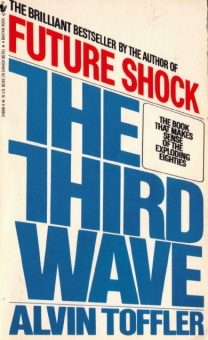THE THIRD WAVE
Two nations took upon themselves the task of reorganizing and reintegrating the Second Wave system: the United States and the Union of Soviet Socialist Republics.
The United States until then had played a limited part in the Grand Imperial campaign. In opening its own frontier it had decimated the Native Americans and cordoned them off in reservations. In Mexico, Cuba, and Puerto Rico, and the Philippines, Americans imitated the imperial tactics of the British, the French, or the Germans. In Latin America throughout the early decades of this century U.S. “dollar diplomacy” helped United Fruit and other corporations guarantee low prices for sugar, bananas, coffee, copper, and other goods.Nevertheless, compared with the Europeans, the United States was a junior partner in the Grand Imperial crusade.
After World War II, by contrast, the United States stood as the chief creditor nation in the world. It had the most advanced technology, the most stable political structure—and an irresistible opportunity to move into the power vacuum left behind by its shattered competitors as they were forced to withdraw from the colonies.
As early as 1941 U.S. financial strategists had begun to plan for a postwar reintegration of the world economy along lines more favorable to the United States. At the Bretton Woods Conference in 1944, held under U.S. leadership, forty-four nations agreed to set up two key integrative structures—the International Monetary Fund and the World Bank.
The IMF compelled its member nations to peg then* currency to the American dollar or to gold—most of which was held by the United States. (By 1948, the United States possessed 72 percent of the whole world’s gold reserves.) The IMF thus fixed the basic relationships of the major world currencies.
The World Bank, meanwhile, at first established to provide postwar reconstruction funds to European nations, gradually began providing loans to the non-industrial countries, too. These were often for the purpose of building roads, harbors, ports, and other “infra-structure items” to facilitate the movement of raw materials and agricultural exports to the Second Wave nations.
Soon a third component was added to the system: the General Agreement on Tariffs and Trade—GATT for short. This agreement, again promoted originally by the United States, set out to liberalize trade, which had the effect of
93
Pages: 1 2 3 4 5 6 7 8 9 10 11 12 13 14 15 16 17 18 19 20 21 22 23 24 25 26 27 28 29 30 31 32 33 34 35 36 37 38 39 40 41 42 43 44 45 46 47 48 49 50 51 52 53 54 55 56 57 58 59 60 61 62 63 64 65 66 67 68 69 70 71 72 73 74 75 76 77 78 79 80 81 82 83 84 85 86 87 88 89 90 91 92 93 94 95 96 97 98 99 100 101 102 103 104 105 106 107 108 109 110 111 112 113 114 115 116 117 118 119 120 121 122 123 124 125 126 127 128 129 130 131 132 133 134 135 136 137 138 139 140 141 142 143 144 145 146 147 148 149 150 151 152 153 154 155 156 157 158 159 160 161 162 163 164 165 166 167 168 169 170 171 172 173 174 175 176 177 178 179 180 181 182 183 184 185 186 187 188 189 190 191 192 193 194 195 196 197 198 199 200 201 202 203 204 205 206 207 208 209 210 211 212 213 214 215 216 217 218 219 220 221 222 223 224 225 226 227 228 229 230 231 232 233 234 235 236 237 238 239 240 241 242 243 244 245 246 247 248 249 250 251 252 253 254 255 256 257 258 259 260 261 262 263 264 265 266 267 268 269 270 271 272 273 274 275 276 277 278 279 280 281 282 283 284 285 286 287 288 289 290 291 292 293 294 295 296 297 298 299 300 301 302 303 304 305 306 307 308 309 310 311 312 313 314 315 316 317 318 319 320 321 322 323 324 325 326 327 328 329 330 331 332 333 334 335 336 337 338 339 340 341 342 343 344 345 346 347 348 349 350 351 352 353 354 355 356 357 358 359 360 361 362 363 364 365 366 367 368 369 370 371 372 373 374 375 376 377 378 379 380 381 382 383 384 385 386 387 388 389 390 391 392 393 394 395 396 397 398 399 400 401 402 403 404 405 406 407 408 409 410 411 412 413 414 415 416 417 418 419 420 421 422 423 424 425 426 427 428 429 430




